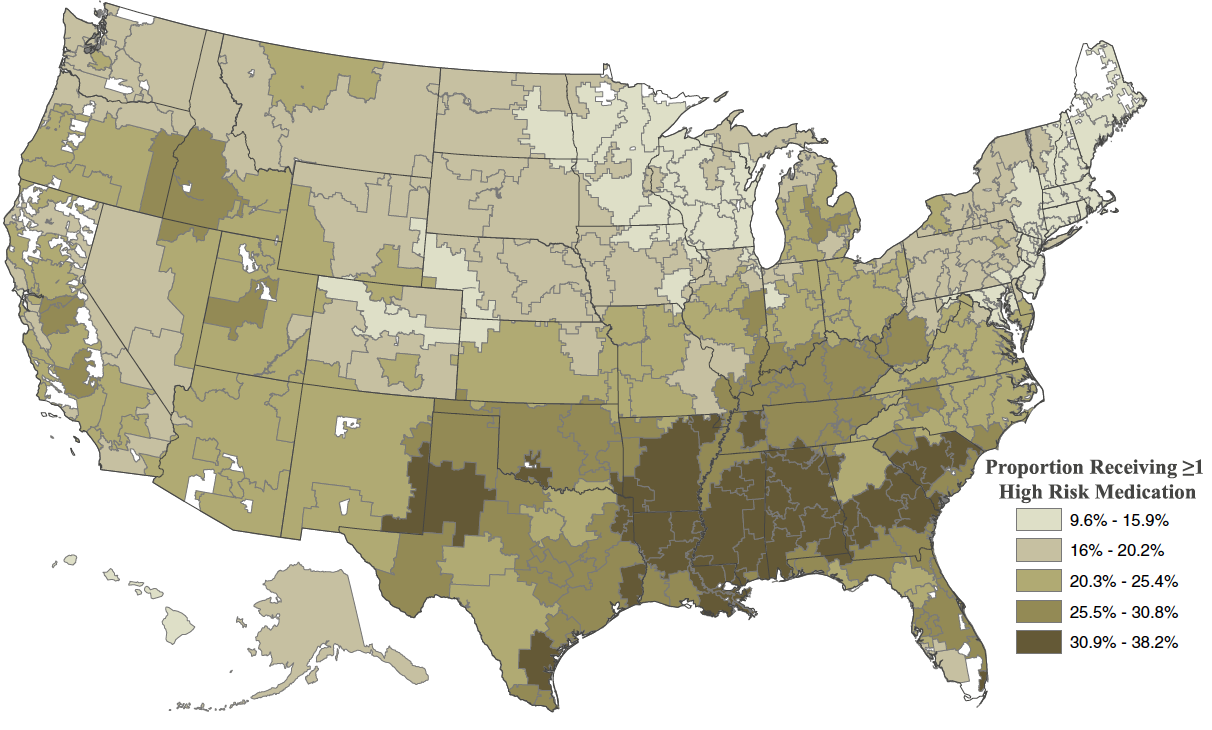AARP Hearing Center
Memo to Doctors: Why Are You Over-Drugging Seniors?
By Candy Sagon, April 17, 2013 07:00 AM

What the heck is going on with doctors in some parts of the country who prescribe risky drugs for older adults?
According to an analysis of more than 6 million seniors on Medicare Advantage, more than 20 percent are prescribed at least one high-risk medication. The problem is most common in the South, among women, and in relatively poor areas, report public health researchers with Brown University.
Risky medications are ones that health authorities have specifically recommended against prescribing to those 65 or older because of severe side effects or the risk of dangerous complications.
In many parts of the South (see the dark-shaded areas of the map), more than a third of those 65-plus are taking drugs considered inappropriate for older adults and for which there are safer alternatives. Ten percent are taking two or more.
"Geography really stands out," coauthor Amal Trivedi, M.D., assistant professor of community health at Brown University's Alpert Medical School, told NPR.org. The study was published in the April Journal of General Internal Medicine.
Researchers found that, nationally, 21.4 percent of the patients in the study, or more than 1.3 million older adults, "received at least one high-risk medication, for which there is often a safer substitute," and nearly 5 percent received at least two.
Researchers based their findings on a list of 110 drugs considered high risk for seniors, compiled by the National Committee for Quality Assurance, a nonprofit group of physicians and health care experts. Many of the drugs can be safely used in younger patients but can cause problems in older adults.
Residents of the South Atlantic, East South Central and West South Central regions of the country, an area stretching from parts of Texas to South Carolina, had a 10 to 12 percent higher risk of receiving potentially harmful prescriptions than did people living in New England, who had the lowest chance, the researchers wrote.
The city with the highest rate was Albany, Ga., where nearly 40 percent of seniors on Medicare Advantage got at least one risky drug, compared with 10 percent in Mason City, Iowa, the area with the lowest rate. The city with the highest rate of seniors receiving at least two high-risk prescriptions was Alexandria, La.
"We started this study because we know that these medications are likely to have more harms than benefits in older patients," Trivedi told the New York Times.
It was unclear why doctors in the South were more prone to prescribing these dicey drugs to seniors, the researchers said. It could be that patients there were more likely to ask for them or that doctors were unfamiliar with safer substitutes.
Whatever the reason, said Trivedi, health care officials and providers "should take the study as a cue to improve prescribing."
In addition, patients need to review the safety and appropriateness of their medications with their doctor or pharmacist.
Map image: Danya Qato/Brown University
Also of Interest
- Walgreens Becomes 1st Retail Chain to Diagnose, Treat Chronic Conditions
- Plastic Surgery On Your Mind? Before You Do That... Do This
- Join AARP: Savings, resources and news for your well-being
See the AARP home page for deals, savings tips, trivia and more































































